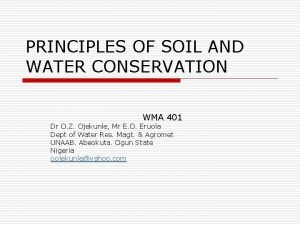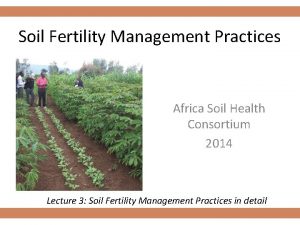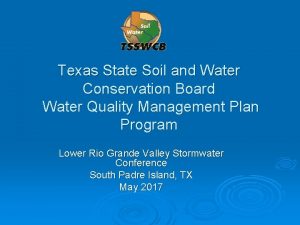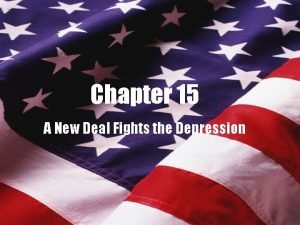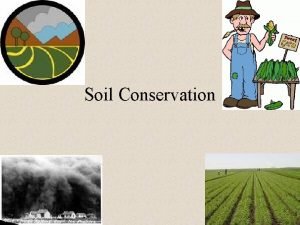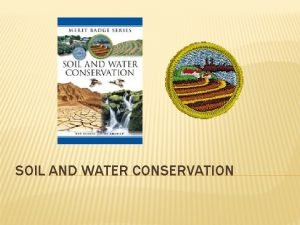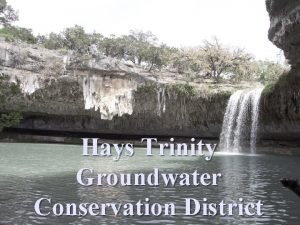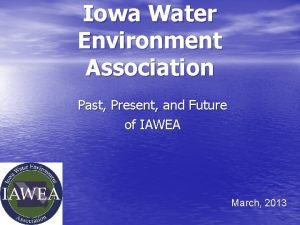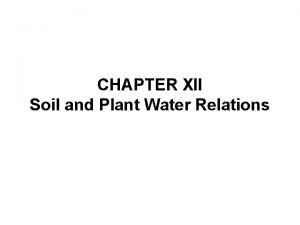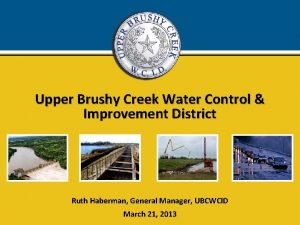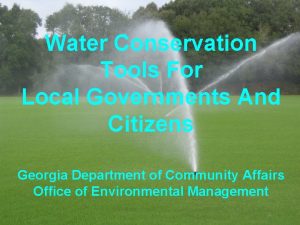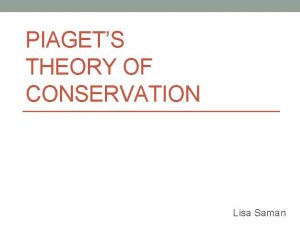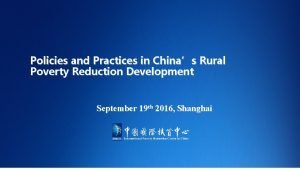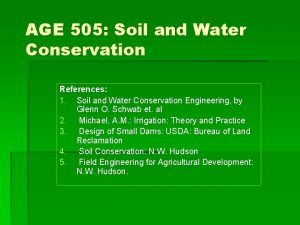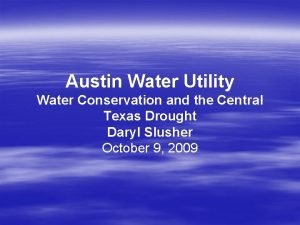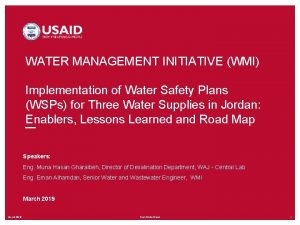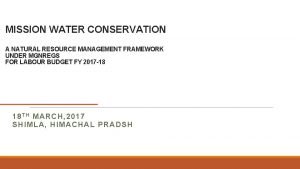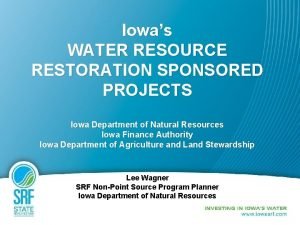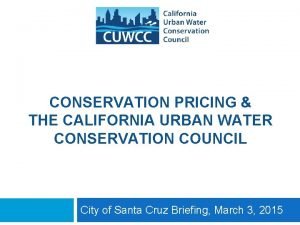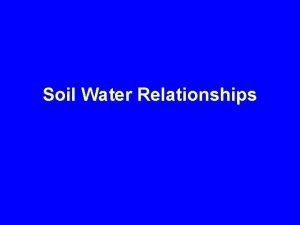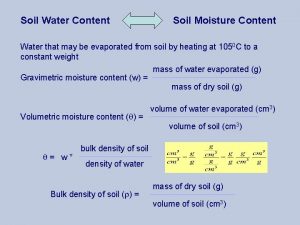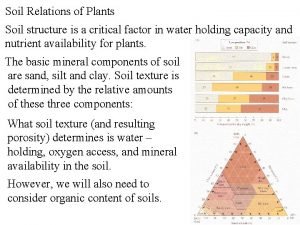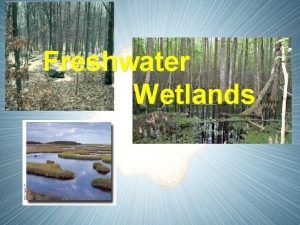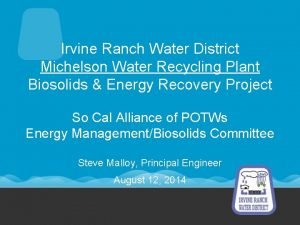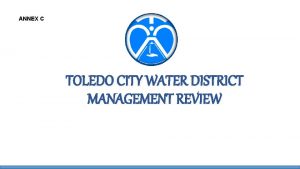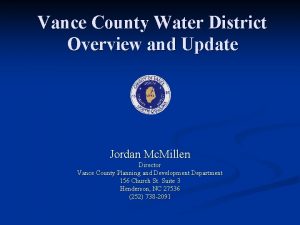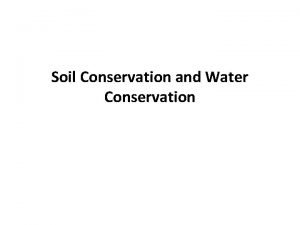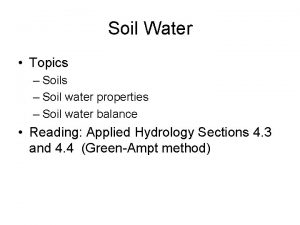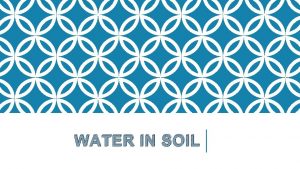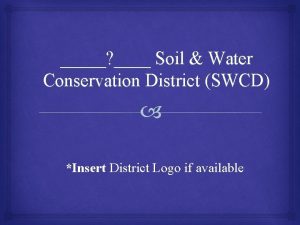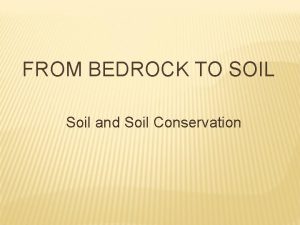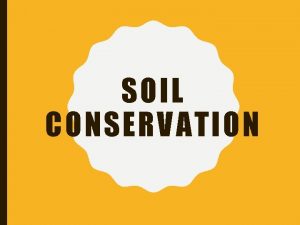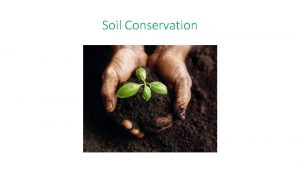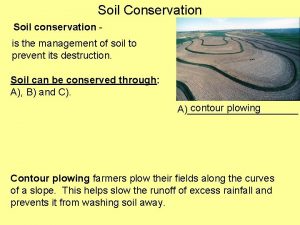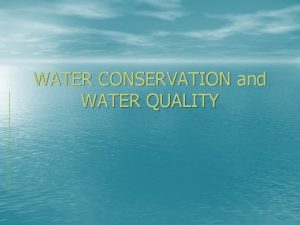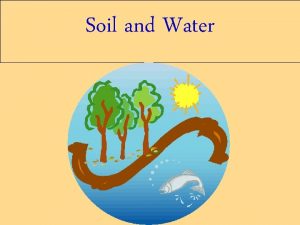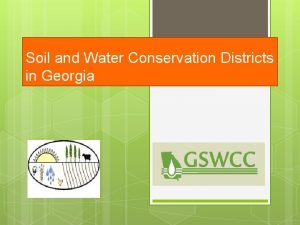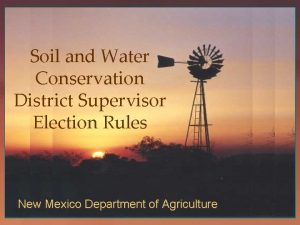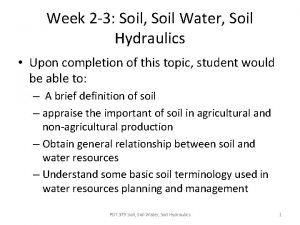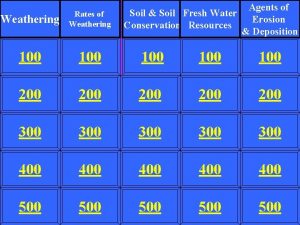Iowa Soil and Water Conservation District Commissioners 69











































- Slides: 43

Iowa Soil and Water Conservation District Commissioners 69 th Annual Conference: Iowa’s Water Quality September 1, 2015 1

Contact Information • Kristine A. Tidgren, Staff Attorney – ktidgren@iastate. edu – 515 -294 -6365 • www. calt. iastate. edu • @CALT_Iowa. State 2

WATER QUALITY ISSUES 3

Contentious Subject Objective Information 4

CLEAN WATER RULE 5

Clean Water Rule • On March 25, 2014, the Environmental Protection Agency (EPA) and the U. S. Army Corps of Engineers (Corps) released a proposed rule defining “waters of the United States” under the Clean Water Act (CWA). • Defines “waters of the United States” subject to jurisdiction of the CWA. • The Corps issues permits for the discharge of fill material, and the EPA issues permits for the discharge of pollutants. • Big deal because permits are expensive and time consuming. Fines for noncompliance are steep. – includes fines up to $37, 500 per day per violation, in addition to criminal penalties 6

Clean Water Rule 7

Clean Water Rule • Agencies have continually urged that rule would not expand the scope of waters “historically protected under the Clean Water Act. ” The rules, they say, just “clarify” which waters are covered. • Opponents say Rule vastly expands jurisdiction of agencies. • Received more than 1 million comments. 8

Clean Water Rule • • • Final rule was released May 27, 2015. Did address some agricultural concerns. Still much uncertainty as to impact. Still much controversy. Agencies’ economic analysis says jurisdiction will expand 2. 84% to 4. 65%. 9

Clean Water Rule Categories Traditional navigable waters Interstate waters Territorial seas Impoundments of jurisdictional waters Tributaries Adjacent Waters Specific Waters Subject to Case-Specific Significant Nexus Analysis • Other Waters Subject to Case-Specific Significant Nexus Determinations • • 10

Tributaries • The final rule retains the general definition of tributary offered by the proposed rule. • . – natural or man-made waters, wetlands, lakes, ponds, canals, streams, and ditches if they contribute flow directly or indirectly to interstate waters. – Must be characterized by the presence of the physical indicators of a bed and banks and an ordinary high water mark. 11

Tributaries • Bed and Banks and Ordinary High Water Mark broadly defined. – Difficult to interpret. • Flow may be intermittent or ephemeral. – Could cover creek beds that are usually dry – Must just flow to the jurisdictional water eventually. 12

Adjacent Waters • Under proposed rule, “adjacent” was defined to include “bordering, contiguous or neighboring” waters. • Final Rule adds a definition for “neighboring, ” which includes: – Waters located within 100 feet of the ordinary high water mark of navigable waters, interstate waters, territorial seas, impoundments, or tributaries – Waters located within the 100 -year floodplain of navigable waters, interstate waters, territorial seas, impoundments, or tributaries and not more than 1, 500 feet from the ordinary high water mark of such water – Waters located within 1, 500 feet of the high tide line of navigable waters or a territorial sea and all waters located within 1, 500 feet of the ordinary high water mark of the Great Lakes 13

Adjacent Waters • Concern over link to tributaries. • Concern that definitions extend federal jurisdiction to a “large variety of waters within floodplains, including lands that are dry most of the year. ” • Categorical inclusion of “waters” as far as 1, 500 feet from dry creek beds (beyond historical wetlands). • Concern that definition of neighboring is not a logical outgrowth of the proposed rule. 14

Clean Water Rule Exclusions • Prior converted cropland • Artificially irrigated areas that would revert to dry land should application of water to that area cease • Artificial, constructed lakes and ponds created in dry land such as farm and stock watering ponds irrigation ponds, settling basins, fields flooded for rice growing, log cleaning ponds, or cooling ponds • Artificial reflecting pools or swimming pools created in dry land • Small ornamental waters created in dry land • Ditches with ephemeral flow that are not a relocated tributary or excavated in a tributary 15

Clean Water Rule Exclusions • Ditches with intermittent flow that are not a relocated tributary, excavated in a tributary, or drain wetlands • Ditches that do not flow, either directly or through another water, into a Traditional Navigable Water, Interstate Water, or Territorial Sea • Water-filled depressions created in dry land incidental to mining or construction activity • Erosional features, including gullies, rills, and other ephemeral features that do not meet the definition of tributary, non-wetland swales, and lawfully constructed grassed waterways • Puddles • Groundwater, including groundwater drained through subsurface drainage systems 16

Legislative Response • In May, House voted 261 -155 to force agencies to withdraw the rule and start over. – H. R. 1732, the Regulatory Integrity Protection Act of 2015. • Senate Bill S. 1140, the Federal Water Quality Protection Act – Hearings held 5/19/2015 in Committee on Environment and Public Works Subcommittee on Fisheries, Water, and Wildlife. – 6/10/2015 Committee ordered that the bill be reported. – 07/16/2015 Placed on Senate Legislative Calendar under General Orders. 17

Litigation Response Four lawsuits involving 27 states filed as soon as Rule was published (June 29). Oklahoma filed later. • * U. S. District Court for Southern District of Ohio: Ohio and Michigan • * U. S. District Court for the District of North Dakota: North Dakota, Alaska, Arizona, Arkansas, Colorado, Idaho, Missouri, Montana, Nebraska, Nevada, South Dakota and Wyoming. Also, includes New Mexico Environment Department and New Mexico state engineer • * U. S. District Court for Southern District of Texas: Texas, Louisiana and Mississippi • * U. S. District Court for Southern District of Georgia: Georgia, West Virginia, Alabama, Florida, Kansas, Kentucky, South Carolina, Utah and Wisconsin 18

Litigation Now 10 similar lawsuits pending. Although the complaints seek multiple forms of relief, they generally ask the courts to declare that the rule is unlawful because it: 1) exceeds the agencies’ statutory authority under the CWA; 2) violates the U. S. Constitution and other federal law; 3) constitutes an arbitrary and capricious “abuse of discretion. ” Specifically, the states ask the court to vacate the rule and prevent its enforcement (Effective August 28). 19

Big Deal to States • Under CWA, states are generally the primary administrators of the permitting process for pollutants and are authorized to assume responsibility for the dredge-and-fill permitting process as well. • In passing CWA, Congress acknowledged the states retained the primary responsibility and right to prevent, reduce and eliminate pollution of their water resources. • Most of the states believe that the new Rule strips them of much of that authority by granting the federal agencies jurisdiction over “extremely wide swaths of intrastate waters and lands. ” • States allege this violates the Tenth Amendment, reserving all powers not delegated to the federal government, to the states. 20

Litigation • MDL No. 2663 - IN RE: CLEAN WATER RULE: DEFINITION OF "WATERS OF THE UNITED STATES" LITIGATION • EPA has filed a motion to transfer all actions to United States District Court for the District of Columbia (MDL). • Hearing October 2, 2015. • Also concern that only appellate court has jurisdiction to hear complaints. That issue has been consolidated in Sixth Circuit. 21

Preliminary Injunction • August 28 was the effective date of the Clean Water Rule. • United States District Court for North Dakota issued preliminary injunction late Thursday. • Judge said that the States are likely to succeed on their claim because: – it appears likely that the EPA has violated its Congressional grant of authority in its promulgation of the Rule at issue, and – it appears likely the EPA failed to comply with APA requirements when promulgating the Rule. 22

EPA Says Now In Effect for 37 States • EPA says injunction applies only to states involved in that lawsuit: North Dakota, Alaska, Arizona, Arkansas, Colorado, Idaho, Missouri, Montana, Nebraska, Nevada, South Dakota, and Wyoming, and the New Mexico Environment Department. • Plaintiffs say injunction applies nationwide. • ND Judge has asked for briefing on topic by 5 pm today. • Georgia and West Virginia courts declined injunction, saying they did not have jurisdiction. 23

Outlook 24

DES MOINES WATER WORKS LAWSUIT 25

26

Timeline • May 29, 2013: Iowa Nutrient Reduction Strategy Unveiled • March 2014: Governor vetoed supplemental appropriation for NRS • March 2014: DMWW began sampling waters from drainage district outflows • January 8, 2015: DMWW voted to proceed with lawsuit • January 9, 2015: 60 -day Notice of Intent to Sue under the Clean Water Act issued • March 16, 2015: Complaint Filed in United States District Court for the Northern District of Iowa • Defendants filed answer on May 21. • Trial date scheduled for August 8, 2016 in Sioux City, Iowa. 27

Federal Complaint • Filed in United States District Court for the Northern District of Iowa (Sioux City) on March 16, 2015 • Filed as a citizen suit under the federal Clean Water Act, 33 U. S. C. § 1251 et seq. and Iowa Code Chapter 455 B. 111. • 52 pages long, plus attachments • Contains 10 “Counts” • Filed against Sac County, Buena Vista County, and Calhoun County Supervisors (in their roles as trustees of drainage districts). • Filed against 13 separately numbered districts (often cited as 10 because of joint management) 28

Federal Complaint • Alleges that ag drainage is significant contributor to hypoxia in Gulf of Mexico. • Scientific research demonstrates that ag drainage has caused high levels of nitrate in Raccoon River water supply. • Alleges $7, 000/day nitrate removal system. $500, 000 in summer of 2013 alone. • Longest period of continuous operation: winter of 2014 -2015 29

Federal and State Water Quality Laws • Primary claim is that drainage districts are “point sources” or nitrate pollution that must comply with federal CWA and NPDES permitting process (administered by IDNR) • Asks court to enjoin all discharges not authorized by permit • Seeks civil penalties for each day of continuing violation 30

Point Source • Alleges that agricultural drainage tiles are “point sources” of pollution. • Only “point sources” are subject to NPDES permit requirements under Clean Water Act. • CWA offers two ag exemptions from “point source” definition: – Ag stormwater – Irrigation return flows 31

Are drain tiles point sources? • DMWW says ag stormwater exemption does not apply because drainage from the tile system is polluted groundwater, not stormwater runoff. 32

Are Drain Tiles Point Sources • EPA has said “no. ” – Note that final Clean Water Rule specifically exempts “groundwater, including groundwater drained through subsurface drainage systems. ” • IDNR has not sought to regulate. – No permitting system in place for drain tile • No federal court has declared farm drain tile “point source. ” 33

Related Federal Case • Pacific Coast Federation of Fishermen’s Associations, et al. v. Glaser, et al. , No. CIV S-2: 11 -2980 -KJM-CKD, 2013 U. S. Dist. LEXIS 132240 (E. D. Cal. Sept. 16, 2013). – Plaintiff said farm drain tile carried polluted groundwater. – Court said farm drain tile not “point source. ” – Under irrigation return flows exception: Congress intended to exempt drainage from farms practicing crop-production agriculture facilitated by irrigation, rather than focusing on the components of a particular flow on any day. – Same reasoning likely applies here: Inseparable interconnection between groundwater and stormwater that seeps into it. – Congress intended to exempt drainage from farms practicing crop-production agriculture from the permitting requirements of the CWA. 34

Other Claims • • • Trespass Negligence Nuisance Property Taken Without Due Process Injunctive Relief 35

Specific Assertions • Conduct of the drainage districts together with the conduct of similarly situated districts contributes to a single, indivisible harm (jointly and severally liable). • Harm to DMWW was a reasonable foreseeable consequence of the districts’ “normal and intended operation. ” • Drainage tiles are a nuisance in their “normal and intended operation. ” 36

Can DMWW Sue Districts? • Iowa case law is clear: drainage districts are not subject to lawsuit for tort money damages under any state of facts. Fisher v. Dallas County, 369 N. W. 2 d 426 (Iowa 1985). • Districts have only those powers granted by legislation (Iowa Code 468) and Iowa Constitution (special and limited powers). – The drainage of surface waters from agricultural lands and all other lands or the protection of such lands from overflow shall be presumed to be a public benefit and conducive to the public health, convenience, and welfare. 37

Powers Granted to Districts • The board of supervisors of any county shall have jurisdiction, power, and authority at any regular, special, or adjourned session, to establish a drainage district or districts, and to locate and establish levees, and cause to be constructed as hereinafter provided any levee, ditch, drain, or watercourse, or settling basins in connection therewith, or to straighten, widen, deepen, or change any natural watercourse, in such county, whenever the same will be of public utility or conducive to the public health, convenience or welfare. 38

Can DMWW Sue Districts? • Only have power to create and maintain drainage system. – Eminent domain (and pay damages) – Assessments • A drainage district is “merely an area of land, not an entity subject to judgment for tort damages. ” • Can only be sued to do what they are required by law to do: create and maintain. (i. e. must fix broken tile) 39

Can DMWW Sue Districts? • DMWW acknowledges this law, but says it violates equal protection and due process. • DMWW calls it immunity. • Iowa Supreme Court says drainage districts are not municipal corporations. • They only have the powers the statute gives them. 40

Can DMWW Sue Districts? • This suit asks for abatement of nitrate or permit: – What power would district have to do this? • • power to regulate land use power to dictate farming practices authority to require buffer zones, etc. power to seek and obtain permit 41

Final Thoughts • Drainage districts are “areas of land. ” All activities of drainage districts are funded by owners of that land. Bottom line: This is really an action against the owners. – Pollution exclusions prevent insurance coverage • This suit involves districts in three counties but alleges claims against all similarly situated districts…joint and several liability. Suggests impleader may be required. • Frustrated with lack of legislative or administrative action, so looking to the third branch of government. “It is because the Governor and his administration have failed to act. ” • Lawsuit will demand significant time, attention, and resources. DMWW just authorized $700, 000 for legal fees. • Potential for wide-ranging impact. 42

Thank You ktidgren@iastate. edu www. calt. iastate. edu @CALT_Iowa. State
 Hudson essex passaic soil conservation district
Hudson essex passaic soil conservation district Objectives of water conservation
Objectives of water conservation Agronomic measures of soil and water conservation
Agronomic measures of soil and water conservation Texas soil and water conservation
Texas soil and water conservation Water and water and water water
Water and water and water water Padstow harbour commissioners
Padstow harbour commissioners Commissioners integrated database
Commissioners integrated database Soil conservation and domestic allotment act
Soil conservation and domestic allotment act Soil conservation and domestic allotment act
Soil conservation and domestic allotment act The new deal fights the depression
The new deal fights the depression Soil conservation
Soil conservation Soil conservation project
Soil conservation project Hays trinity gcd
Hays trinity gcd Living soil vs dead soil
Living soil vs dead soil Four major spheres of the earth
Four major spheres of the earth Iowa water environment association
Iowa water environment association Soil and water relationship
Soil and water relationship Upper brushy creek water control and improvement district
Upper brushy creek water control and improvement district Lakehaven water
Lakehaven water Water conservation tools
Water conservation tools Jean piaget conservation
Jean piaget conservation Preoperational reasoning stage
Preoperational reasoning stage Concrete operational stage
Concrete operational stage Water conservation project
Water conservation project Water conservation references
Water conservation references Water conservation in hotel industry
Water conservation in hotel industry Austin water rebates
Austin water rebates Water conservation project
Water conservation project Mission water conservation under mgnrega
Mission water conservation under mgnrega Water conservation project
Water conservation project California urban water conservation council
California urban water conservation council Soil
Soil Water retention in soil
Water retention in soil Soil texture water holding capacity
Soil texture water holding capacity Water content of soil
Water content of soil Soil texture water holding capacity
Soil texture water holding capacity An ecosystem in which water either covers the soil
An ecosystem in which water either covers the soil Difference between ecology and environment
Difference between ecology and environment A tiny groove in soil made by flowing water
A tiny groove in soil made by flowing water Darcy's law
Darcy's law Michelson water reclamation plant
Michelson water reclamation plant Toledo water district
Toledo water district Contra costa water district rebates
Contra costa water district rebates Vance county water district
Vance county water district

